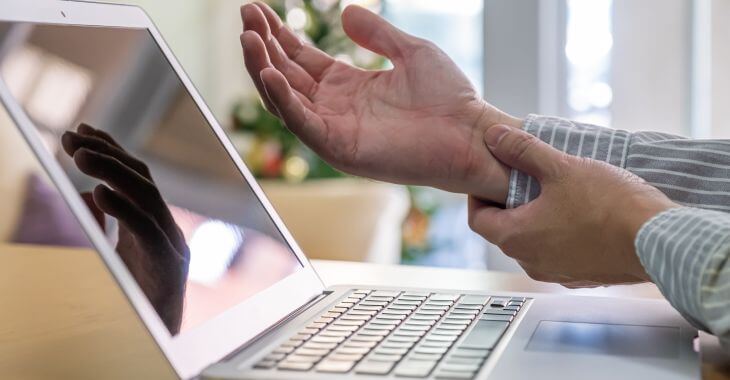Effective Ways to Relieve Wrist Pain from Typing

Wrist pain from typing is a common issue faced by individuals who spend extended hours working on computers. The repetitive motion of typing can lead to discomfort and pain in the wrists, affecting productivity and overall well-being.
Fortunately, there are several effective strategies to relieve wrist pain and prevent further discomfort. The following are practical tips and exercises to promote wrist health for individuals who spend significant time typing and how to relieve wrist pain from typing.
Ergonomic Workspace Setup
One of the primary contributors to wrist pain is an improperly configured workspace. A wrist rest can provide additional support and cushioning, reducing the pressure on your wrists while typing. Ensure that the wrist rest is positioned correctly to maintain a neutral wrist posture.
It is essential not to rely solely on a wrist rest – combining its use with proper ergonomics and breaks is key to effective pain relief. If you are experiencing inner or outer wrist pain, you may be able to get relief by changing your workspace. Consider these changes:
- Ensure that your desk, chair, and computer peripherals are ergonomically positioned.
- Your wrists should be in a neutral position while typing, meaning they are neither excessively flexed nor extended.
- Invest in an ergonomic keyboard and mouse to support a more natural wrist alignment, reducing strain during prolonged typing sessions.
Making a few ergonomic changes to your workspace is a wise investment in your wrist health.
Invest in a Quality Chair and Desk
The overall ergonomics of your workspace extend beyond the keyboard and mouse. A
supportive chair and a properly adjusted desk can contribute significantly to preventing wrist pain. Ensure that your chair provides adequate lumbar support, and your desk allows for comfortable typing heights.
Proper Typing Technique
Adopting a correct typing technique is crucial in preventing and relieving wrist pain. Maintain a relaxed posture, keeping your wrists and hands in a neutral position. Avoid excessive force when pressing keys and allow your fingers to glide over the keys rather than forcefully striking them.
Take Breaks and Stretch
Frequent breaks are essential for preventing wrist pain. Incorporate short breaks into your work routine, allowing your wrists to rest and recover. During these breaks, perform simple stretches to improve flexibility and reduce tension. Some wrist stretches to perform include:
- wrist flexor stretches
- wrist extensor stretches
- circular motions
Regularly performing these stretches can help alleviate stiffness and enhance blood circulation and help relieve wrist pain from typing.
Ice and Heat Therapy
Applying ice or heat to your wrists can provide relief from inflammation and pain. Use an ice pack wrapped in a cloth for 15-20 minutes to reduce swelling. Alternatively, a warm compress or warm towel can help relax the muscles and improve blood flow. Do not apply ice or heat directly to the skin.
Wrist Exercises
Incorporate wrist exercises into your daily routine to strengthen the muscles and improve flexibility. Exercises such as wrist curls, wrist extensions and finger taps can help enhance the overall health of your wrists. Perform these exercises regularly, especially if you engage in prolonged typing sessions.
Compression Gloves
Compression gloves can be beneficial in managing wrist pain. These gloves provide gentle compression, which can reduce swelling and promote blood circulation. Wear compression gloves during typing sessions or when experiencing discomfort to support your wrists.
Wrist Conditions Caused by Excessive Typing
Prolonged and repetitive typing can contribute to various wrist conditions, often collectively referred to as Repetitive Strain Injuries (RSIs) or Cumulative Trauma Disorders (CTDs). These conditions result from the continuous stress placed on the muscles, tendons and nerves in the wrist and hand.
If you have wrist pain from typing, it may be a sign of the following conditions:
- Carpal Tunnel Syndrome (CTS): Carpal Tunnel Syndrome is a common condition that occurs when the median nerve, which runs through the carpal tunnel in the wrist, becomes compressed or irritated. Symptoms may include numbness, weakness and wrist pain.
- Tendinitis: Tendinitis is the inflammation of tendons, and it can affect the tendons in the wrist due to repetitive motions, such as typing. It can result in pain, swelling and stiffness in the affected tendons. The pain may worsen during or after typing.
- Tenosynovitis: Description: Tenosynovitis involves the inflammation of the sheath surrounding a tendon, and it can occur in the wrist as a result of repetitive movements. Pain, swelling, and difficulty moving the affected wrist can occur.
- De Quervain’s Tenosynovitis: This condition involves the inflammation of the tendons on the thumb side of the wrist.
- Ganglion Cyst: Ganglion cysts are noncancerous lumps filled with synovial fluid that can develop near joints, including the wrist. A visible lump or swelling on the wrist, along with pain or discomfort, particularly during movement.
- Wrist Sprain: Repetitive stress on the wrist from typing can lead to sprains, which involve the stretching or tearing of ligaments.

Relieving wrist pain from typing involves a combination of ergonomic adjustments, proper technique, breaks and exercises. By implementing these strategies into your daily routine, you can significantly reduce discomfort and prevent serious wrist conditions.
Remember that if wrist pain persists or worsens, it is crucial to consult with a healthcare professional for a comprehensive evaluation and personalized advice. Prioritizing wrist health is essential for individuals who rely on typing for work or leisure to ensure sustained comfort and productivity.
The information provided on this website, including text, graphics, images, and other materials, is intended solely for informational purposes and should not be used as a substitute for professional medical advice, diagnosis, or treatment.


)